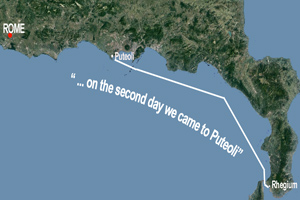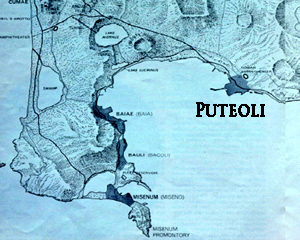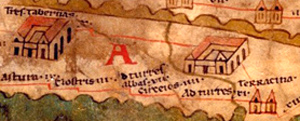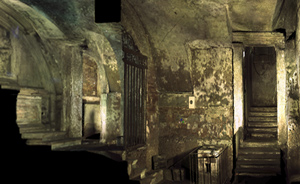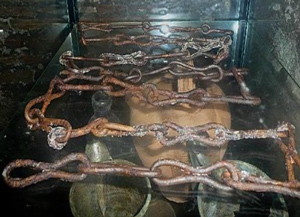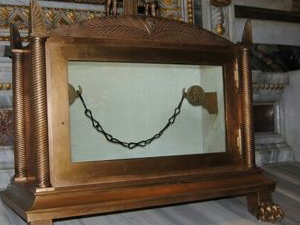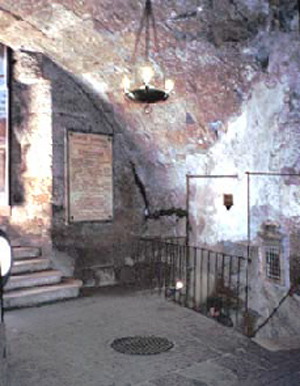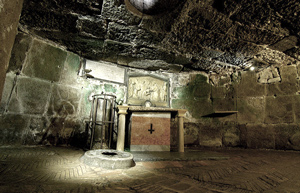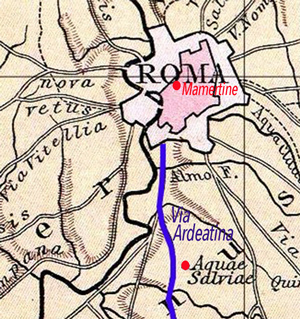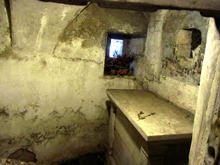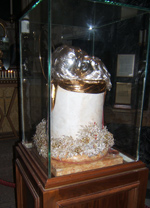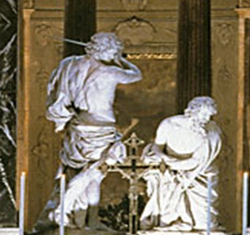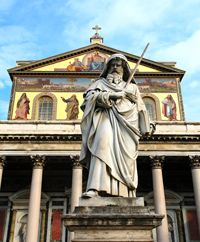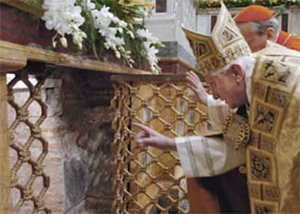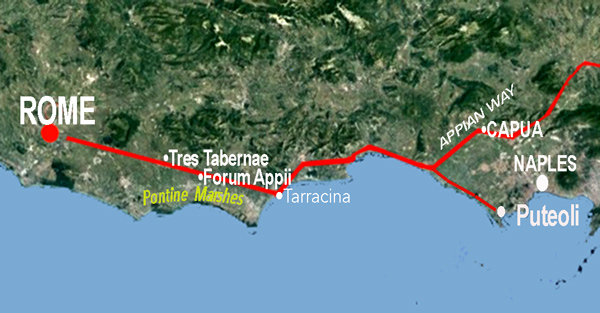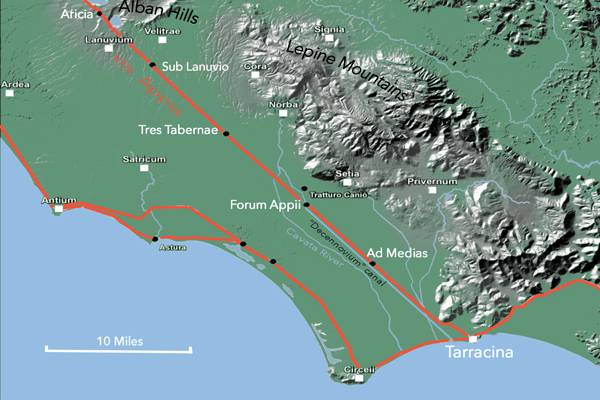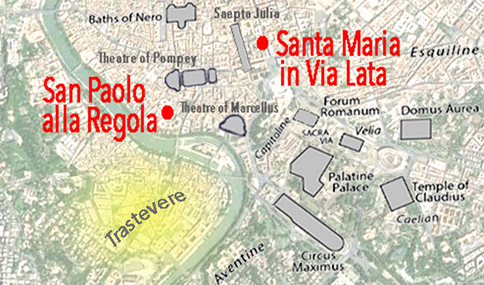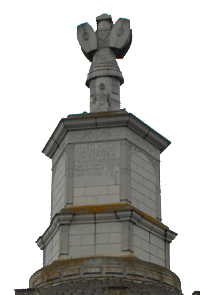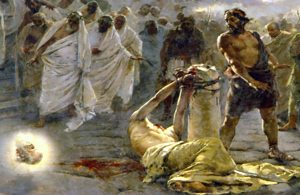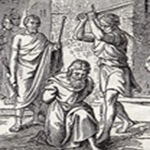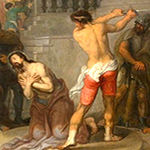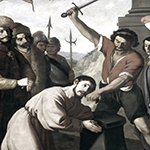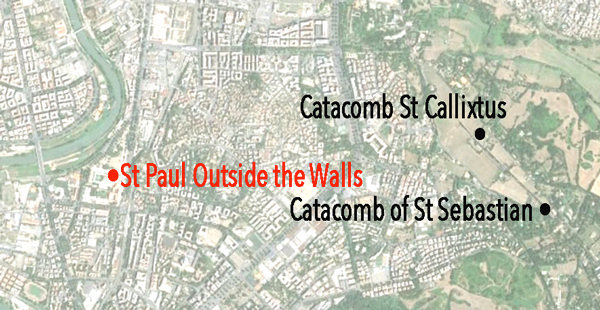
Discuss the world's favourite imaginary friend on the JNE YouTube channel
See Rome and Die?
Old yarn but new door (2008, St Paul Outside the Walls, Rome)
In the Epistle to the Romans "Paul" tells us of an earnest desire to visit the Christians of Rome.
He claims that he has "no more any place in these regions" to evangelise (15.23) – a quite ludicrous claim. Literally hundreds of cities of the eastern Mediterranean never saw a trace of Paul.
Acts of the Apostles tells us that Paul resolved to go to Rome during his time in Ephesus:
"Paul resolved in the Spirit to pass through Macedonia and Achaia and go to Jerusalem, saying, 'After I have been there, I must also see Rome.' " – Acts 19.21
This was soon after he had expelled evil spirits from the sick. This he did remotely by passing out handkerchiefs that had touched his skin (Acts 19.12) – a trick not even performed by Jesus!
But Rome he "must" see!
Lift off. Paul leaves Judea for Rome in 59 AD ?
Acts would have us believe that Paul was the top priority of the procurator Porcius Festus, when the Roman official arrived in Caesarea (Acts 25.1,27)
Numismatic evidence of Festus in Judea show coins stamped "Caesar Nero Year 5", in other words, the year 59 AD.
In that case, Paul's supposed voyage to Rome was in the Autumn of 59, followed by the 3-month castaway on Melite during the winter months of 59/60.
Therefore the "two whole years" of house arrest in Rome would be the years 60/61 and 61/62 – far too early for Paul to be caught up in the fire that devastated the city in the summer of 64 AD !
Arrival in Italy
Paul's itinerary: two days by sea from the toe of Italy at Rhegium to reach Puteoli – and then a week's stay with local Christians?
The port at Puteoli
Puteoli was a major entry point into Italy. The young Josephus landed here on his way to Rome (Life, 3.16). He reports that there was a considerable Jewish element in the population of the port (Antiquities 17.12).
Puteoli declined in importance after the new port of Portus at Ostia was built. This enlarged harbour was started by Claudius and completed by Nero.
The 4th century Acts of Peter and Paul identifies the brethren who greeted Paul at Puteoli as "some of Peter's disciples".
Travel speed on the Appian Way
For the Roman army a regulation day's march (during summer) was 20 miles, or, in exceptional cases, 24.
Tacitus records that in a disgraceful retreat from Armenia the troops of Paetus "in one day covered a distance of forty miles, abandoning his wounded everywhere." - Annals 15.16
"I know not how the ancient Romans came to take such short Journeys over this Way, which was then in its perfection, as not above fourteen miles in a day: So computed from Horace's Account of his Journey from Rome to Brundusium ..."
– Edward Wright, Some observations made in travelling through France, Italy, &c: in 1720, 1721 and 1722, p135
Three Taverns and Appii Forum
4th century Peutinger map
"I shall wait for you till the 7th of May at Formia. So now let me know what day we shall see you. From Appii Forum, ten o'clock – I sent another a short time ago from Three Taverns."
– Cicero, Letter 10, to Atticus, Rome
Where DID they get their ideas from?
" Big welcome for a priest of Mithras "
In 66 AD, after a nine-month progress from the east, Tiridates reached Italy. His purpose was to kneel before Nero and receive the crown to the Armenian throne.
This extravagantly expensive charade had been three-years in preparation, a face-saving settlement to Rome's conflict with Parthia. Tiridates, in fact, was a brother of the Persian king Vologases I and already ruled Armenia.
Nero went forward to the port city of Puteoli to receive his "conquered" guest and entertain him with gladiatorial shows and athletics. Together they journeyed to Rome from where crowds came out to greet them.
In the spectacular "Golden Day" of celebration that followed, Tiridates paid obeisance to Nero, but then, as a high priest of Mithraism, inducted Nero into the eastern cult.
Paul's hired dwelling?
Santa Maria in Via Lata
Ancient warehouse. Paul was here?
"Tradition" has it that two thousand years ago this crypt below Santa Maria in Via Lata was Paul's house-prison.Then again, another "tradition" makes the same claim for foundations below San Paolo alla Regola.
The claims can't both be true – but they can certainly both be fake!
Foundation of ancient insula
San Paolo alla Regola
Chains of Paul?
What more proof do you need than chains? Santa Maria in Via Lata, Rome.
A similar chain is to be seen at the Basilica of St Paul Outside the Walls.
Can't have too much of a good thing, eh?
Basilica of Saint Paul Outside the Walls, Rome
Paul's chain? Its authenticity was vouched for by Pope Leo I in the 5th century. Leo who also claimed to have Peter's prison chain, gifted from Jerusalem.
Unaffordable
"Unlikely that Paul was able to afford a private house during his two years in Rome … [yet] the increasing numbers of Jewish leaders Paul received and his later reception of all who came to hear him suggests … there must have been sufficient room for such gatherings."
– B. Rapske, The Book of Acts and Paul in Roman Custody, 237
San Paolo alla Regola
Within the church an architrave bears the inscription Divi Pauli Apostoli Hospitium et Schola – the Lodging and SCHOOL of the Apostle St Paul!
San Paolo alla Regola - entrance to oratory
Did the apostle teach here?! This particular part of the circus was restored during the "Pauline Year" – 2008-2009.
The Mamertine – a suitably grim prison for "Peter and Paul"
Upper level
"There is a place called the Tullianum, about twelve feet below the surface of the ground. It is enclosed on all sides by walls, and above it is a chamber with a vaulted roof of stone. Neglect, darkness, and stench make it hideous and fearsome to behold."
– Sallust, War with Catiline (LV)
Lower level
Peter, it's said, was chained to the pillar (left of altar above). The circular stone on the floor shows were he miraculously produced a spring with which he baptised other prisoners.
Note that the cross on the altar is upside down, in memory of Peter's novel crucifixion.
Yeah, right.
Finding Christ in jail
Holy Nonsense
Paul was taken 6 miles from the Mamertine prison to Aquae Salviae to cut off his head.
Why?
St Paul at the Three Fountains (Aquae Salviae)
Another "holding cell" for Paul.
This particular St Paul's church also features reddish stones (stained by blood of the apostle) and part of the column on which Paul was beheaded.
"Pillar of beheading"
The larger part of Paul's pillar of beheading is to be seen in St Paul Outside the Walls – not forgetting that a third portion is displayed on the island of Malta!
Yes, it was quite some pillar.
Part of the "pillar of beheading" in Malta.
Off with his head! ... Milk!?
"And when the executioner struck off his head, milk spurted upon the cloak of the soldier."
– Acts of Paul
Place of abode?
Place of execution?
or just a place of adulation!
Basilica of St Paul Outside the Walls, Rome
Excavations have confirmed the presence of a cemetery under and around the basilica.
One of the bodies surely must have been Paul?
"Yes, that's Paul's bones", says Pope
In June 2009 Benedict confirmed that tiny fragments of bone from a 4th century stone sarcophagus long venerated in St Paul's Basilica, were from the apostle Paul. Traces of purple cloth and fragments of gold sequins placed the identification "beyond all doubt".
As luck would have it, the discovery coincided with the end of the Vatican's "Year of honour" for the apostle.
Glory!
The Many Deaths of Paul
1-5. "From the Jews five times I received forty stripes minus one." (2 Corinthians 11.24)
6- 8 "Three times I was beaten with rods."
9. "Once I was stoned."
10-12. "Three times I was shipwrecked; a night and a day I have been in the deep." (2 Cor.11.25)
13. Stoned at Lystra (Acts 14.19)
14. Earthquake in Philippi (Acts 16.26)
15. Fought beasts at Ephesus (1 Corinthians 15.32)
16. Venomous snake bite on Malta (Acts 28.3)Jewish plots: The Jews – en masse, it seems – demanded Paul's execution in Jerusalem.
17. "Away with such a fellow from the earth, for he is not fit to live!" (Acts 22.22)
18. "Jews bound under a great curse to kill Paul." (Acts 23.12).
Paul, the valiant soldier for Christ and tireless missionary, finally arrived in Rome, a prisoner in chains delivered to his fate. Surely there would be a big finish to such an illustrious career? But no, the final chapter of Acts of the Apostles fizzles out, with its hero living in his own rented house, a Roman guard for company, and receiving all that came to him. Two whole years passed and the apostle preached the kingdom of God and the Lord Jesus without hindrance. End of. Such an ending, whilst sufficient for the first edition of the story, clearly left later Christians frustrated. When and how had Paul died? Surely it was as a martyr? Had he not indicated in his letter to the Romans a desire to visit Spain? From that it was reasoned – by "tradition" of course – that Paul had been released from his house arrest and made another missionary journey, not just to Spain but also to Crete and elsewhere. The apostle was then re-arrested, returned to Rome, imprisoned a second time and then executed by Nero after the great fire! This ridiculous itinerary made it possible for Paul to be associated with the "first persecution" of the Church and newly written "pastoral" epistles (1 Timothy, 2 Timothy, Titus.) could be presented as "authentic". Pious romances, scribbled between the 2nd and 4th centuries, such as Acts of Paul, the Apocalypse of Paul, the Martyrdom of Paul and the Acts of Paul and Thecla – provided additional fabulous nonsense, including Paul's beheading on the very same day as Peter! Nothing in secular history confirms the fate of St Paul – but then nothing in secular history confirms even his existence. Even without the accretions of legend and Christian imagination, Paul's sojourn in Rome is a fabricated deceit.
"To Caesar you shall go" One of the more famous tales concerning Paul is the "appeal to Caesar", an entitlement derived from his supposed "Roman citizenship". But what exactly were the charges brought against the apostle? The nearest we get to a description of his offenses is Acts 24.5 where an attorney named Tertullus presented the case to the governor Marcus Felix on behalf of the Jewish high priest. Paul was accused of being "an agitator among Jews throughout the world and a ringleader of the sect of the Nazarenes", in other words a political agitator. Paul defended himself against this charge by sidestepping and proclaiming his belief in the law, the prophets and the resurrection of the dead. Oddly, Felix did not adjudicate but merely adjourned the case until "Lysias the tribune comes down" (24.22) – an event that never happened and left Paul in prison in Caesarea for two years!
After those two years Porcius Festus replaced Felix as procurator and the new man invited the Jews to again present their charges. This time there were "many (unspecified) serious charges" (25.7). Festus, it seems, had been expecting political crimes and was dumbfounded by mere religious quibbles:
Would the Romans really have committed a centurion and the cost and trouble of a sea voyage to Rome to a minor sectarian with whom they had no issue? Would Paul have been shipped off to Rome on "charges" which were religious infringements that meant nothing to the Romans? The "appeal to Caesar" is pure invention, a plot device already anticipated by the very words of Jesus two years, and a few pages, earlier, after Paul's trial before the Sanhedrin in Jerusalem:
Now that was a miracle. Bon voyage According to the fable, in short order, Paul was placed on board a ship. During the hazardous (and fantastical) voyage to Rome an angel appeared to Paul and repeated the words of Jesus: Paul "must" appear before Caesar.
And once Paul had made landfall in Italy, how would Christians in Rome – supposing for the moment they even existed – actually have known that Paul had arrived? "Word", of course, somehow had to go ahead ("He's coming, he's coming!") – but that's when problems with this wondrous tale really mount up.
And how on earth did Paul and his companions "find brethren" in the town of Puteoli? Outside of the Christian dreamscape, were Christians really so numerous or so easily identified? The nearby city of Pompeii shows absolutely no evidence of 1st century Christians (e.g.) and no church in Puteoli is attested before the 5th century. How likely was it that the "brethren" of Puteoli would or could offer a week's accommodation not just to Paul, but also to the centurion Julius in whose custody Paul was being held, plus "certain other prisoners" (Acts 27.1), plus Paul's companion Aristarchus, and the ("we") author of Acts? And this tally takes no account of the original ship's complement of 276 that had sailed from Myra (Acts 27.37). Had they all, perhaps, decided to make a new life in Melite or Sicily?! The author of Acts, in fact, had a good reason for "holding" Paul in Puteoli for a week: he wanted his hero of the faith to enter Rome in style and to applause, the Pauline equivalent of the entry of Jesus into Jerusalem on Palm Sunday. Yet Puteoli was 170 miles from the capital. News of Paul's approach had to reach the city well before Paul arrived or how else could the brethren of Rome had come out to meet him?
Arrival – and one week's stay in Puteoli?
The canal, the Decennovium, drained the road and was fed by the Canata River just beyond a river harbour at Forum Appii. Making the rest of the journey on foot, news of Paul would have taken at least a week to reach Rome. Even if a horse rider had been despatched almost immediately from Puteoli to carry the good news post-haste to the capital three days would have passed before his arrival. And what would his message have been?
• Are we really to believe that Paul enjoyed such a towering reputation among brethren in the capital that excitement and anticipation impelled them to make such a journey? What did they know of the man? Supposedly, he had just passed an uneventful two years in a jail in Caesarea. In reality, the admiring crowd was no more than a literary device to aggrandise the hero of Acts. • With another two days or more to make the return trip, would slaves and freedmen – the natural clientele for primitive Christianity – really have gotten several days "leave" to go off to meet and greet an enigmatic holy man? Weren't there lots of those in Rome already? • Even supposing these first Christians in Rome were independent Jewish artisans ("tent makers", perhaps?!) would they really have had the time to spare? Time would have been required for a group to be organised or individual brethren to be informed, and after all, Paul was imminently arriving in Rome anyway. No wonder the author of Acts had the Christian grandee "tarry" seven days at Puteoli!. Several days at the very least were required for an adoring audience to be assembled.
The brethren from Rome come out to greet Paul – fifty-five miles from Rome? " And so we came to Rome. The believers from there, when they heard of us, came as far as the Forum of Appius and Three Taverns to meet us. On seeing them, Paul thanked God and took courage." – Acts 28.15
Elated brethren, making the journey south from Rome to greet Paul at the 55th milestone, was a scenario born from theological purpose not historical reality. The imaginary scene sketched by the author of Acts – of respectful believers, determined at all costs to identify with the apostle on the road and accompany him on a triumphal entry into the capital of the world – was for the edification and delight of later generations. What, after all, had Paul done for the Christians of Rome – sent them a letter several years earlier? With the undeniable fact that "persons unknown" had established the church in Rome, what was there really to make the man from Tarsus such a star attraction? He was the salesman of "God's grace."
The oh so wonderful Epistle to the Romans
For some, the great theological treatise of the New Testament, a profound exposition of the doctrinal system of the Christian religion. To more grounded minds, a turgid, tedious and irrelevant discourse of vacuous nonsense: sin (fifty-seven mentions), faith (forty-four mentions), righteousness (thirty-six mentions) and grace (twenty-one mentions). Insomniacs and masochists might enjoy such delightful verbiage as:
Actually, real Romans nowhere get a mention in the Epistle to the Romans, though Jews and Greeks are referred to thirteen times. There is absolutely nothing of the gospel Jesus here, no Nazareth or virgin birth, no perambulating ministry with twelve disciples, no astounding miracles or sublime teachings. Were the cosmic events of just two decades earlier so trite and well-known that not a single word was merited? Remarkably, the closest "Romans" gets to a crucifixion is a metaphorical reference to "our old self crucified with him" (Romans 6.6). Given that Paul is supposedly writing to the first Christian converts in Rome, it is quite bizarre that "Paul" makes no reference to his own "road to Damascus" encounter with the risen Jesus, an event that supposedly changed his life. And why would existing "believers" in Rome be in need of such a didactic letter as Paul's Romans? Did they believe the wrong things? On the face it, the document is identified as the Epistle to the Romans only because "Rome" is mentioned twice in the opening greeting (1.7 and 1.15) but even those mentions are absent in some early copies of the tract. In origin Romans was clearly a statement of theology – the first draft of which was probably penned by Marcion but redacted repeatedly by Catholics. That draft was adapted as an "epistle to the Romans" by the expedient of adding "Rome" into the opening salutation. And the epistle is certainly no letter. At around 7000 words in the original Greek (9000 words in English) a hand-written copy would run to more than thirty sheets of papyrus, a preposterous endeavour for an "occasional letter". What gives the game away is the final chapter, arguably an authentic letter in its own right though over blown with name checks. The common assertion is that Paul wrote Romans whilst in Corinth around the year 58 AD, in anticipation of his first visit to Rome. The reality is that Romans was never written by a single author nor at such an early date but is a pastiche of various strains of nuanced theology redacted over a considerable period of time during the 2nd century. No such "letter" as Romans energised the mid-1st century Christians of Rome – even assuming they even existed.
A Cornucopia of Absurdities!
Paul, we're told, was allowed to "live in his own hired dwelling" – an extraordinary indulgence of a prisoner ("Roman citizenship" not withstanding!) Where did Paul's companion Aristarchus and the writer of Acts stay, one wonders? In a city crowded and short of housing for those who flocked there from across the empire, how on earth did Paul ("in chains"!) find a dwelling so quickly and pay the rent for the next two years?
Are we to imagine a modest villa? And if so, how was that paid for? The antique Christian archaeologist William Ramsay (still much loved by the godly, though he did most of his work in the 1880s) was obliged to conclude that the meandering apostle supported himself from "hereditary property"!
Summoning (and warning) the Jews?!
Who were the Jewish leaders that so readily accepted the summons from a renegade Jew from out of town? Rome had a sizable Jewish population in the mid-1st century so how exactly did Paul contact the leading men? Would they have even heard of the man from Tarsus? ("We have received no letters from Judea about you, and none of the brothers coming here has reported or spoken any evil about you." – Acts 28.21) As if that wasn't absurdity enough, the Jews then agreed to return to Paul's house for a whole day's lecture from the heretic ("from morning until evening" – Acts 28.23).
Would not the Jewish leadership years before have confronted the unnamed proselytisers who had brought the Christian heresy to the city? The rabbis surely did not need a lecture from Paul! Paul's alleged encounter with the Jews of Rome is decidedly not kosher. But Acts assures us that such was the remarkable persuasive power of the apostle that after their one-day seminar some of the Jewish leaders "believed". Was the ancestral religion of the Jews so easily abandoned ? Another claim that is preposterous. Interestingly enough, in enlightening the Jews the apostle made no reference at all to a human Jesus nor even referred to his own encounter with the risen Jesus on the road to Damascus. Instead, Paul "expounded on the law of Moses and the prophets". His Christ Jesus came from "revelation" and scriptural re-interpretation. "Paul" confirmed that the charges against him were religious: "It is for the sake of the hope of Israel that I am bound with this chain", he insisted (Acts 28.20). Jewish leaders would not have been impressed. Acts claims Paul succeeded in sowing dissension among the Jews but "knew" the Gentiles would listen.
Happy days in Rome?
Paul had claimed in his epistle to the Romans that his policy was not to work where the gospel had already been preached ("not where Christ was already named" - 15.20) and it seems that the faith of the Christians in Rome was so renown that it was already "proclaimed in all the world" (1.8). This was even before Paul wrote his epistle to them. The church in the capital had evidently existed for "many years" (15.23) before Paul showed up. Paul's original intent had been "to pass through" Rome, enjoy the community of saints for a while, and then travel on to Spain:
Paul resumed his preaching mission in the capital and, "without hindrance", continued to do so in the comfort of his own home for two full years. Paul had thus fulfilled the Lord's command "to testify about me in Rome" even if he hadn't fulfilled the angel of God's command to "stand before Caesar."
The Christians in Rome? In the mid-1st century there were as yet no gospels, so what on earth did these primordial believers believe? It is argued by some that the very earliest Christians in Rome were among the "3000" who heard Peter's multilingual address at the first Pentecost in Jerusalem ("Devout Jews from every nation ... visitors from Rome, both Jews and proselytes ..." – Acts 2.5,10). The violent sound of "fiery Holy Spirit" had drawn a crowd together and Peter had reminded those assembled of Jesus's deeds of power, wonders, and signs ("done among you as you yourself know"). So the specious argument goes that Roman Jews, witnesses themselves of marvels and baptised by apostles, had returned to Rome with their heads ringing with Lord Christ Jesus. Thus a Christian presence in Rome had self-generated from witnesses of miracles returning from Jerusalem. No charismatic apostolic founder figure had been required. By a similar logic, Christian communities could have been established everywhere else and the whole "apostolic mission" would have been undermined. What we have here, in the "persons unknown" origin of the church in Rome, is implicitly (though certainly not explicitly!) an acknowledgement that Christian fraternities emerged from earlier enthusiasms that had preceded them – Judaism itself, and various cults blended in an ongoing syncretism. Jews from Rome (perhaps freed slaves) may have visited Jerusalem for some particular festival and then returned to Rome "radicalised" by their experience. Rather than stand witness to miracle, and encounters with characters talking about miracles, the more rational probability is that they imbibed some strain of messianic expectation, nothing more.
And then ... a trip to Spain? What happened to Paul subsequent to his two-years of home-based sermonising? History is silent but holy liars are ever active.
There are obvious problems for the theory that Paul evangelised in Spain. One of them is that Spanish church gives the honour of "founder apostle" to James, the brother of John (Santiago!). Then again, there is no evidence of 1st century Christianity in Spain at all! Did Paul simply die of old age, perhaps? His struggle seems to have been against jealousy, not a vicious Roman emperor. There is nothing here about death in Rome, Nero, or the burning of Christians.
Death becomes you - Acts of Paul As we saw above, the first allusion to the death of Paul is to found in that a massive diatribe known as "1 Clement". But in fact, Eusebius, the 4th century church historian, made no reference to 1 Clement when establishing the supposed martyrdom of Paul (and Peter) although he discusses this so-called "epistle" at length.
The first testimony that is quoted by Eusebius (Church History 2.25) dates from more than a hundred years later than Clement, from a certain Caius. This Caius (possibly a presbyter in Rome during the papacy of Zephyrinus, 199-217) is reported to have written "But I can show the trophies of the apostles. For if you will go to the Vatican or to the Ostian way, you will find the trophies of those who laid the foundations of this church." In the Roman world, of course, trophies went with triumphs, and we have already seen Paul had a "triumphant entry" into Rome. But tropaea constructed by sectarians claiming to be persecuted is extremely unlikely. Were the Christians not supposedly hiding in the catacombs at the time of Paul's death?! Of course these trophies would not long have existed anyway because later Christian basilicas were constructed on the sites where supposedly they had stood. But even extant trophies would prove nothing about when, where or how Paul died. Eusebius next cited Dionysius, a late 2nd century bishop of Corinth, who made the startling claim that Peter and Paul had taught and died together in Rome :
Eusebius throws in his own bit of questionable evidence at this point, reporting that the names of Peter and Paul were "preserved in the cemeteries of that place even to the present day." But in the ancient world the names of thousands of fabulous entities were preserved, in burial grounds, public spaces, and popular shrines. That made none of them real. The only reality is that Peter and Paul had been "planted" in Rome.
The witness of Tacitus? NO! It should be noted that, in substantiating the supposed "persecution of Nero," Eusebius does NOT cite the notorious passage 15.44 from the Annals of Tacitus so beloved by today's apologists! This is especially telling because Eusebius, rather than cite the Roman historian (which he does nowhere in his history), chooses instead to recycle the vague assertion made by Tertullian, writing more than a century later than Tacitus, that Nero was the "first persecutor of the church". Nearly two centuries after the alleged persecution, Tertullian urged his readers to "examine your records" without indicating his actual source:
Tertullian is most notable for his quip about throwing Christians to the lions ("What, all of them? to a single lion?") but he was also the first to say that Peter had been crucified: "Peter suffered a passion like his Lord's" (On the Prescription of Heretics, 36). As for Paul, Tertullian reported that "Paul was crowned with the death of John" (that is a beheading, like John the Baptist). This contradicts the boast ascribed to Ignatius more than a century earlier, that the wannabe martyr "wanted to be found in the footsteps of Paul" and yet that meant being fed to the beasts! (Ignatius, Ephesians 12, Romans 1).
A fantasy itinerary for Paul – but then again, they are all fantasy! In its wildest incarnation Paul's later career is even more dynamic than the earlier career recorded in Acts. It is all based on a ludicrous over-interpretation of just a few verses from the fake pastoral epistles. Having made the claim that Paul travelled to Spain and the west, it seems the pastoral epistles suggest that Paul also travelled back to the east! One claim is that Paul left Rome for Spain and then returned to Ephesus. From here Paul visited the other churches of Greece and wrote his first letter to Timothy. This claim is squeezed from a single verse:
From Greece, it has been asserted, Paul took ship to Crete and then again returned to Ephesus, where he wrote his letter to Titus. This is derived from: "When I send Artemas or Tychicus to you, do your best to come to me at Nicopolis, for I have decided to spend the winter there." (Titus 1.12). With the epistle of Titus moving Paul to Nicopolis, Paul's arrest (at Nicopolis, or perhaps at Troas, where Paul left some belongings), and transport back to Rome, is extracted from just a couple verses of 2 Timothy:
A second jail term and martyrdom ?! Whether it was to Spain or somewhere else, Paul supposedly left Rome and returned to the city some years later. A chronology of this last period of Paul's life is even more problematic than earlier episodes, not least because all the claims are "traditions" woven around interpretations of epistles which themselves are inauthentic. Our only safe footstep is that if Paul existed and if he was transported to Rome as claimed by Acts, his first detention lasted until 62. Did Paul, perhaps, return to Rome of his own volition or was he still being hounded by dastardly Jews? Was there no second dramatic voyage to Rome, involving, say, a shipwreck and snakebite miracle or something similar, worthy of the great apostle? How long was Paul's second prison term? Was there a new charge against him or was he simply caught up in the Neronian persecution, if such an event even occurred? Did he die in 64 or as late as 68? Why did "Luke" stop documenting his hero before these crucial episodes? According to the "traditions" about Luke himself, he lived to a ripe old age of 84.
Fabricating "tradition" – the Mamertine prison Is it remotely creditable that the original Christians of Rome, who traipsed for days just to share with Paul his first entrance into the city, not only showed no such interest in his second arrival just a few years later, but also failed to record a single word about his imprisonment, his trial, his execution and his burial?To all of these questions we have only the "imaginative" answers from a later age. Papal ambition and pious credulity supplied what history failed to provide. Thus a suitably grim prison was identified in which Peter and Paul "must" have spent their final days. With a few added artifacts, such as chains and graffiti, authenticity was confirmed and a "tradition" was born. Thus it was that the first and oldest prison in Rome, the Tullianum, was retroactively drawn into the Christian fable. Located on the eastern slope of the Capitoline hill, close to the forum, the lower, subterranean level of the prison had originally been a water cistern. A spring (hence the name) rose through a hole in the floor and drained into the main sewer (Cloaca Maxima). During the republican period this chamber became a holding cell for state prisoners, many held pending an inglorious display in a Roman triumph. Others simply died in this dark and damp dungeon, the only entry to which was a hole in the floor above (today there is an added flight of steps). The prisoners, often naked, were lowered or thrown into this hellhole. Now try to imagine this … Paul writing his "2nd epistle to Timothy" from the Tullianum – and writing this!
The Tullianum was integrated into the Christian dreamscape sometime between the 5th and 7th centuries, when it was added to the pilgrim trail and repurposed for Christian worship. By then it was known as the Mamertine. Even the spring itself was given a role in the faux drama. It owed its existence, supposedly, not to an ancient aquifer but to a miracle of Peter, who used its waters to "baptise other prisoners". The "healing waters" would thereafter be a fillip to the burgeoning pilgrim trade.
Paul loses his head
From the three points where Paul's head bounced three springs gushed forth. Apart from the assurance of the 4th century Acts of Peter and Paul, convincing evidence of this is provided by three languid fountains which show precisely where Paul's head touched the ground. Well, not any more. They were closed off in 1950 as a health hazard. But three close altars within the church mark where they were. Apparently. Aside from this absurd nonsense, the question to ask is, Why traipse Paul six miles to cut off his head? The best apology that defenders of the faith can muster is to suggest that a too public execution might have "caused a stir." Inmates of the Tullianum – Sejanas, the deposed praetorian prefect of Tiberius, for example – were killed on the spot, their corpses exposed on the Gemonium stairs or thrown into the forum. So what was so appealing about about the area around Aquae Salviae? For one thing, the district was sacred to the ancient fertility goddess Dea Dia (one of the cults revised by Augustus) and the spring here had a venerable history long before Christianity claimed it as its own. By so doing, yet another bit of Rome's pagan heritage was expropriated by the cult of Christ. Although risible, the story of Paul's "bouncing head" worked well enough during centuries of ignorance and gullibility and inspired some fine but misleading art.
Bones with a life of their own The body (and presumably head!) of Paul was collected by the Christian brethren after his execution and given a respectful burial. Such, at least, is the "tradition". Probe the "tradition" for details, however, and all is opaque. History is silent and "tradition" affords no agreement as to the origin of later veneration. It appears that "a Christian woman named Lucina" was associated with the burial of Paul in each of three centuries. The church in Rome began burying its dead in catacombs during the pontificate of Zephyrinus (198-217), at a time when the church was acquiring land near Rome. Zephyrinus' administrator for the Christian catacomb was a thief and deacon (later pope), Callixtus (aka Callistus), who gave his own name to the cemetery on the Appian way. Here early popes had their tombs, so why not Peter and Paul? This was a period when rival Christian factions contended often violently with each other (and the first of the "Anti-Popes"). The problem was that a rival necropolis, also on the Appian way, also claimed to be the resting place for the apostles' bones. Apparently, the remains of Peter and Paul had been "hidden" in the catacombs of St Sebastian during the reign of Vespasian (69-79). But then a counter claim related that the relics of Peter and Paul had been moved to the catacombs of St Sebastian only in the 3rd century, in the time of emperor Valerian (253-260). Either way, the catacomb of St Sebastian acquired the aura of a cult site, and today has much holy graffiti on its walls to illustrate the centuries of veneration to Peter and Paul. Without saying which of the competing graveyards actually had the holy bones, the Book of the Popes relates the story that the relics of Paul and Peter had remained "ad Catacumbas" until the time of Pope Cornelius (251-253), when Paul got shifted to a resting ground on the Via Ostiensis and Peter found himself on the Vatican hill.
The massive church which stands on the spot is known as San Paolo fuori le Mura (St Paul Outside the Walls), and the walls in question are the Aurelian Walls built between 271-275. The original basilica here was built by Constantine, on a sepulchral area reputedly owned "by a Christian woman named Lucina" (transferred back from the 3rd century to the 1st century!) Not to waste a good yarn, it was also Lucina (now transferred forward into the 4th century!) who retrieved the body of St Sebastian from a sewer and buried it in the catacomb of Callixtus! Sebastian was also buried in the near by catacomb that bears his own name. The cult site at St Sebastian, the tropaeum of Paul on the road to Ostia, and the tropaeum of Peter on the Vatican hill, may be burial places, temporary resting places for bones, meeting places of early believers, or simply monuments that celebrate bogus martyrdoms. It could be that the bones of Paul and Peter had been carefully tagged for over two hundred years before reaching their final destinations. Or it could be that an ambitious church constructed a place of veneration and pilgrimage for its gullible flock.
The power of myth
Not a word has any fidelity to historical truth. But having achieved a death in Rome the real miracle of Paul began, the miracle of imposing a Pauline landscape on a city that had honoured the gods of polytheism for a millennium. Over the coming centuries the resourceful mind of religious fraudsters responded with aplomb, creating a Pauline Rome to delight the faithful and instil faith in the doubtful.
Sources: Digital Augustan Rome
Copyright © 2016
by Kenneth Humphreys.
|
||||||||||||||||||||||||||||||||||||||||||||||||||||||||||||


